7 Ways to Support Emotional Wellness at Work
Last Updated Sep 17, 2025

Stress isn't just creeping into the American workplace — it’s exploding. Companies are losing$322 billion a year to burnout-fueled turnover and lost productivity. And employees are running on empty faster than ever. Today’s workers are burning out by 25. That’s nearly 20 years earlier than their parents.
Stress, anxiety, and emotional fatigue have become business as usual. And it’s crushing morale. Engagement drops. Teams unravel. Top talent walks.
Emotional wellness can’t live on the perks shelf anymore. It needs a seat at the strategy table.
HR leaders like you have the power to flip the script. You can design cultures that protect people’s energy, build resilience, and actually support emotional health — not just talk about it.
Uncover the benefits of prioritizing emotional wellness — and get actionable steps to create a workplace where people can truly thrive.
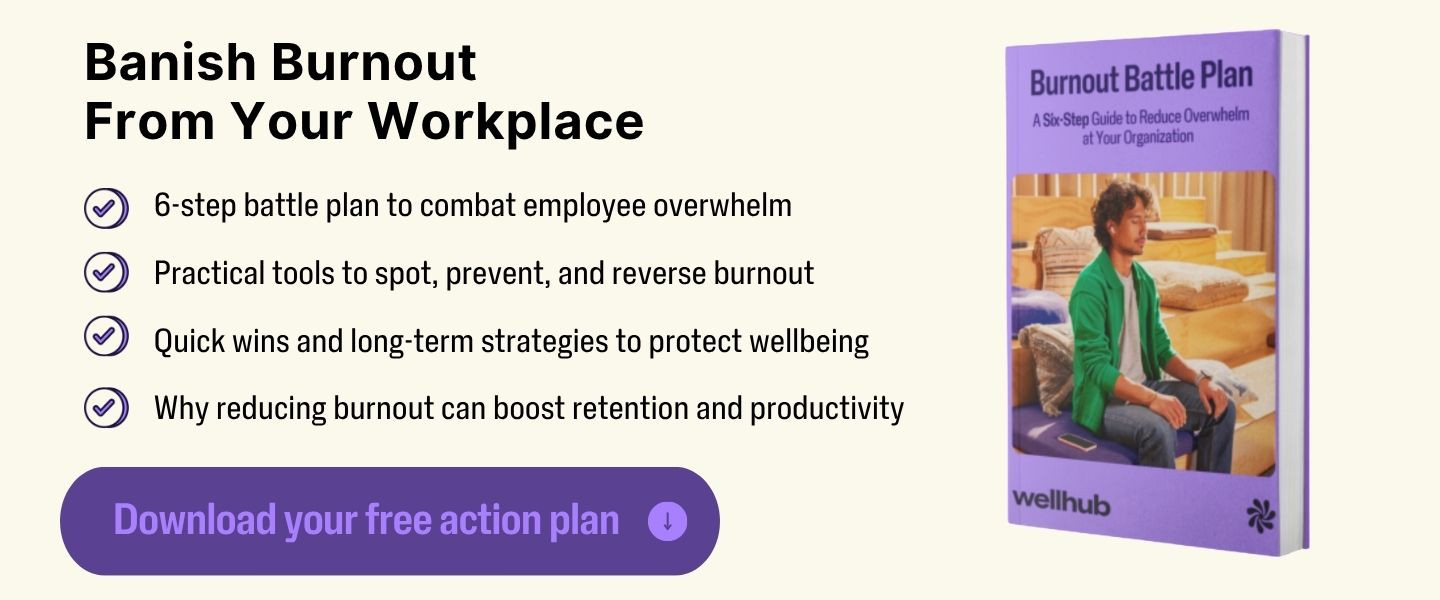
What You'll Learn
- The current state of employee emotional wellness in U.S. workplaces (2023–2025) – and why it’s an urgent issue, backed by eye-opening statistics
- How emotional wellbeing (or lack thereof) impacts your organization’s turnover, productivity, culture, and ability to attract talent
- Seven actionable strategies to build an emotionally healthy workplace – from leadership buy-in and manager training to robust wellbeing programs and recognition practices
- Ways to empower employees with resources for stress management, resilience, and support, creating an environment where it’s safe to seek help
- Solutions to common HR challenges (like stigma, budget constraints, and measuring ROI) and answers to frequently asked questions so you can confidently champion emotional wellness initiatives
What is Emotional Wellness in the Workplace?
Emotional wellness in the workplace is the state in which employees feel supported, valued, and able to manage stress and emotions in a healthy way.
This goes beyond just the absence of mental illness or stress – it’s about actively cultivating positive emotional health on the job. An emotionally well employee can handle day-to-day pressures, adapt to changes or setbacks. They maintain a sense of purpose and foster positive relationships with colleagues.
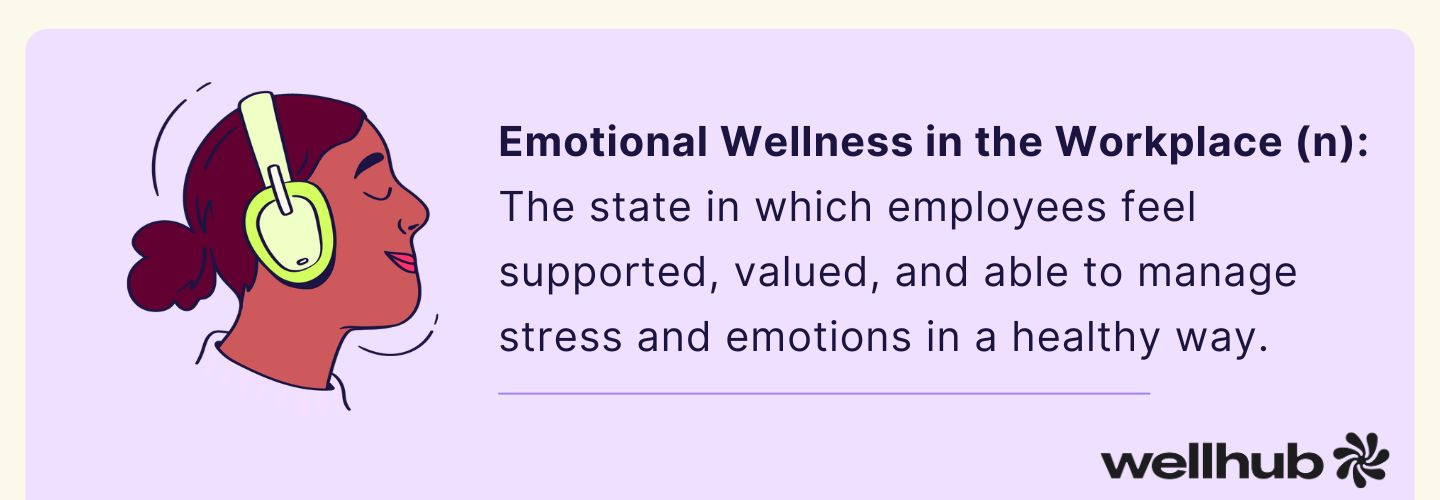
Key Components of Emotional Wellness in the Workplace
Emotional wellness is not a solo endeavor – the workplace environment plays a huge role. Supportive policies, empathetic leadership, and open communication all contribute to how safe and valued people feel at work. Achieving emotional wellness in the workplace involves multiple facets of the work experience. Here are five key components and what they mean in practice:
Work-Life Wellness
More than simply balancing responsibilities, work-life wellness is a generative state where personal and professional experiences amplify each other. It goes beyond just preventing burnout—it’s about creating conditions where employees can thrive in both domains. This may look like flexible scheduling that supports family or passion projects, managers who encourage professional growth alongside personal development, and organizational cultures that normalize unplugging and recovery. When work-life wellness is prioritized, employees don’t feel they must trade personal fulfillment for career success: The two reinforce one another.
Stress Management & Resilience
Providing tools and a culture that help employees manage stress and build resilience. This could mean offering stress-management resources (like mindfulness training or counseling), promoting regular breaks, or simply normalizing that it’s okay to ask for help when overwhelmed. Resilient employees recover faster from setbacks and maintain productivity under pressure.
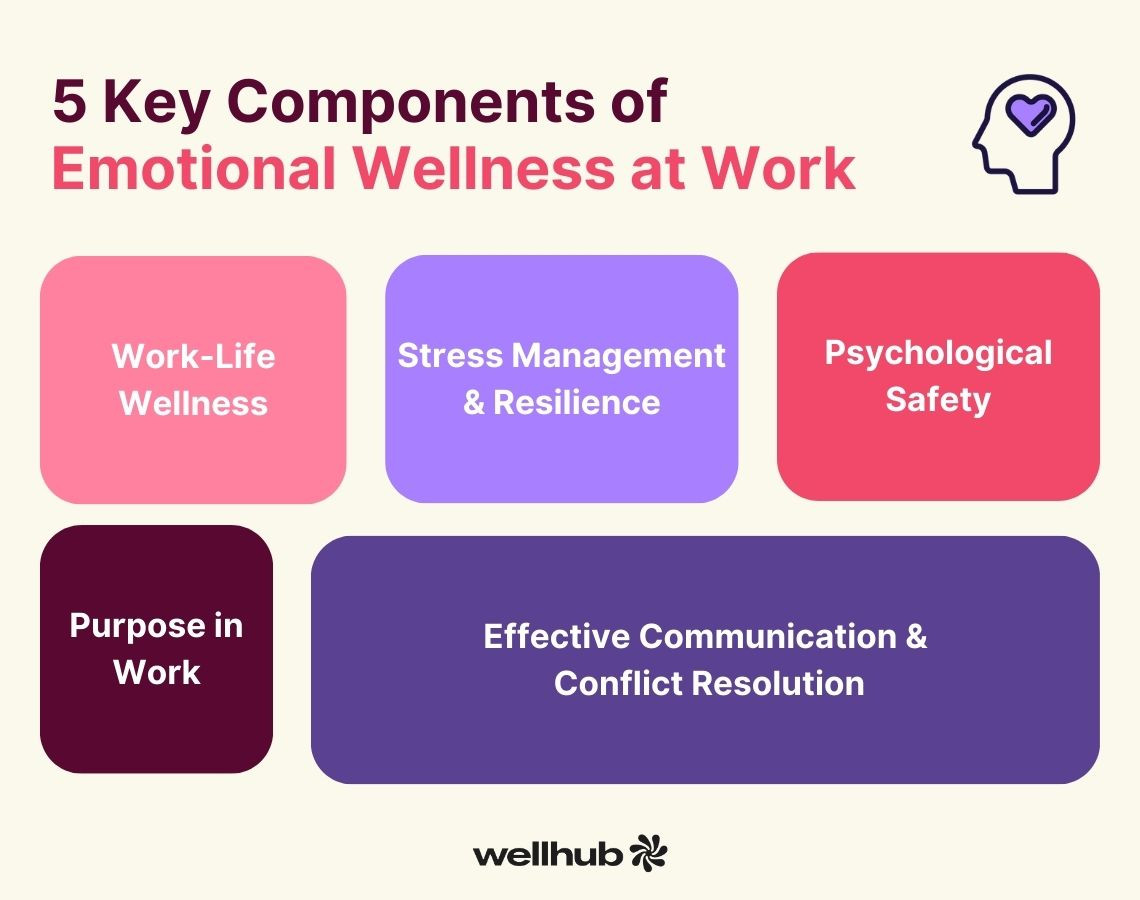
Effective Communication & Conflict Resolution
An emotionally well workplace encourages open, respectful communication. Employees should feel able to voice concerns or disagreements without fear. Training in conflict resolution and empathy can help teams navigate tensions or misunderstandings. When people address issues constructively, it prevents negativity from festering.
Psychological Safety
This is the foundation of innovation and trust. A psychologically safe workplace means employees feel secure to speak up with ideas, questions, or mistakes, knowing they won’t be punished or ridiculed. When people aren’t constantly on guard, their stress levels drop and engagement rises. Psychological safety often comes from inclusive leadership and zero-tolerance for harassment or bullying.
Meaning and Purpose in Work
Finally, emotional wellness thrives when employees find purpose in their roles. This doesn’t require grandiose missions for every job, but it does mean helping people see how their work contributes to a bigger picture. Recognition and feedback help here. When employees feel their work matters, they’re more likely to experience positive emotions like pride and motivation.
By focusing on these components, HR leaders can create an ecosystem where emotional wellbeing is supported from all angles – policies, management practices, and everyday team culture.
Build psychological safety with these data-backed strategies.
Emotional Wellness in the Workplace: U.S. Trends and Statistics (2025)
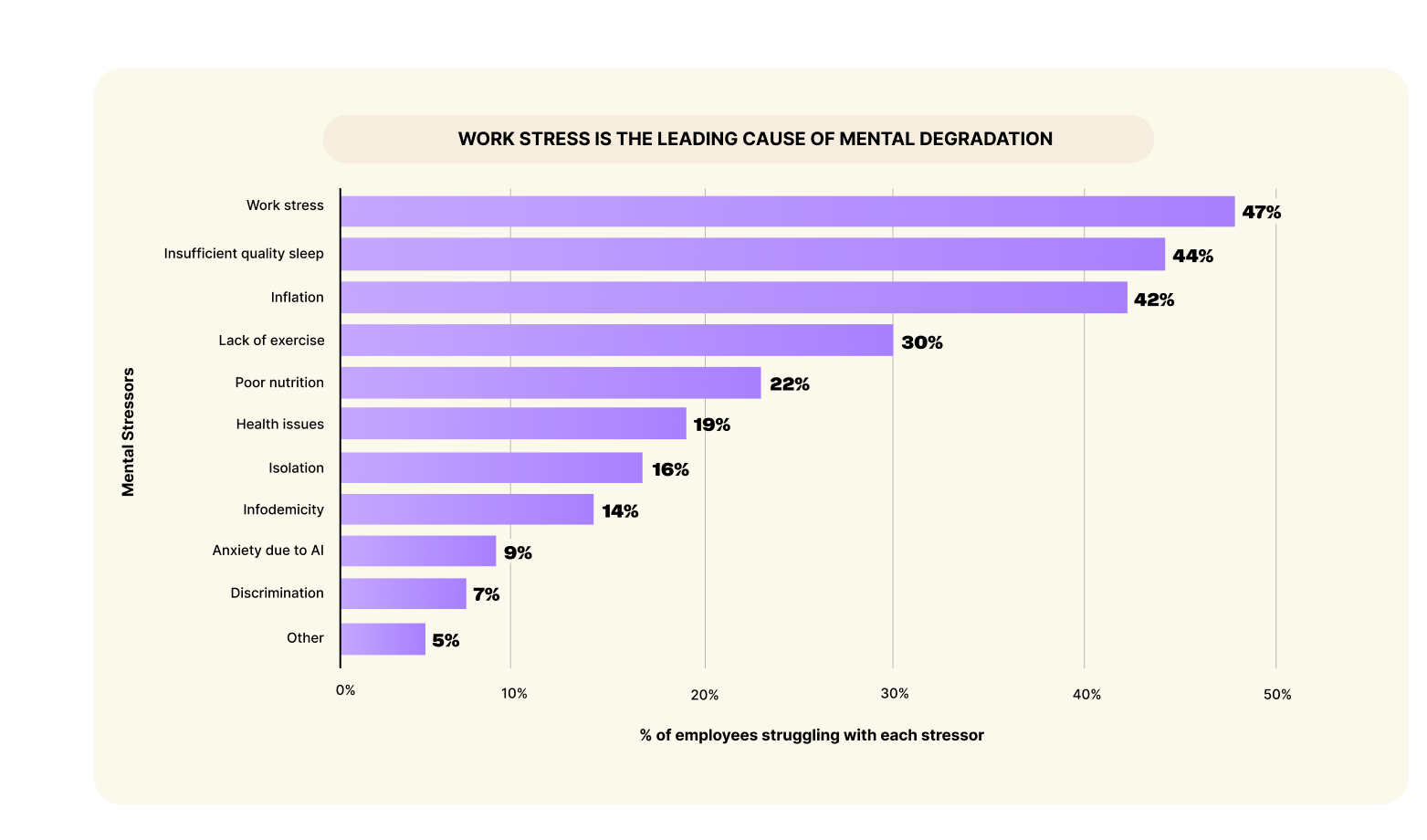
Emotional wellness in the workplace is a pressing concern. Employees across the U.S. (and globally) are reporting higher stress, more burnout, and greater impacts on their health and performance than ever before.
- Widespread Stress and Burnout: Workplace stress is near all-time highs. In 2023, a Gallup survey found that 52% of workers in the U.S. and Canada experienced significant stress “a lot of the day” – a record high. Similarly, about 44% of U.S. employees say they feel burned out at work, and 45% feel “emotionally drained” by the end of the day. These aren’t just occasional rough days; for many, excessive stress has become a daily reality.
- Deteriorating Mental Health: The toll on mental health is alarming. Nearly half (47%) of employees say work stress is degrading their mental wellbeing, making it the leading cause of emotional health issues, above inflation and isolation. The result? Rising levels of anxiety, depression, and employees who feel “used up” before the workweek is done.
- Economic Costs to Organizations: Emotional distress doesn’t sit at home – it shows up as real dollars lost at work. Burnout and unchecked stress lead to mistakes, disengagement, sick days, and ultimately people quitting. Recent analyses peg the annual cost of lost productivity and turnover due to employee burnout at $322 billion globally. For perspective, that’s roughly 20% of the total payroll for the average company being eaten up by stress-related losseswellhub.com. Employers also face higher healthcare expenses, with stress-linked conditions driving up insurance claims.
- Generational and Demographic Disparities: Younger workers are feeling the heat the most. Surveys in 2024–2025 reveal that Gen Z and Millennial employees report hitting “peak burnout” by their mid-20s, whereas older generations tended to peak in their 40s. Additionally, women in many workplaces report higher burnout rates than men, reflecting the persistent pressures of balancing work with other responsibilities. While stress affects everyone, understanding these disparities helps HR tailor support (for example, offering extra mentorship for young professionals or flexibility for those juggling caregiving roles).
- Cultural and Support Gaps: Finally, there’s a gap between needs and support. A striking 83% of employees say wellbeing is as important to them as their salary, and 88% believe employers have a responsibility to support it. Yet just 59% of employees rate their workplace wellbeing support as “good” or “excellent.” Half of workers say they don’t feel comfortable using mental health resources provided by their employer– often due to stigma or fear of negative career impact. This means even when companies have programs, they might not be engaging employees effectively. The culture around emotional wellness is as important as the programs themselves.
In short, the U.S. workforce is grappling with an emotional wellness crisis. Stress and burnout are pervasive, cutting across industries and job levels. The costs – human and financial – are steep and escalating.
The data is clear: Organizations that fail to support emotional wellness risk a downward spiral of unhappy employees, higher turnover, and lower performance. The urgency is real, but so is the opportunity. By understanding these trends, HR leaders can make the case for change and start turning these numbers around.
The Business Imperative: Why Emotional Wellness Matters for Your Organization
Emotional wellness isn’t just about caring for employees (though that alone is a noble goal) – it’s about smart business. When employees struggle emotionally, the organization struggles, too. Conversely, a workforce that feels supported and balanced fuels success.
Here’s why prioritizing emotional wellness in the workplace should be at the top of your strategic agenda.
Dive deep into how workplace wellness can make your organization more successful.
Reduced Turnover & Increased Retention
One of the clearest business cases for focusing on emotional health is employee retention. Stressed-out, burned-out employees are far more likely to quit. In fact, 83% of employees say they would consider leaving their company if it doesn’t focus on wellbeing. That means eight out of ten of your people are watching how you handle this. And high turnover is expensive – replacing a single employee can cost anywhere from half to two times their annual salary in recruiting and training.
By investing in wellness, you signal to employees that you value them as humans, not just workers. The result? They’re more likely to stick around. Companies with robust wellbeing programs report significantly lower voluntary turnover, saving money and retaining institutional knowledge.
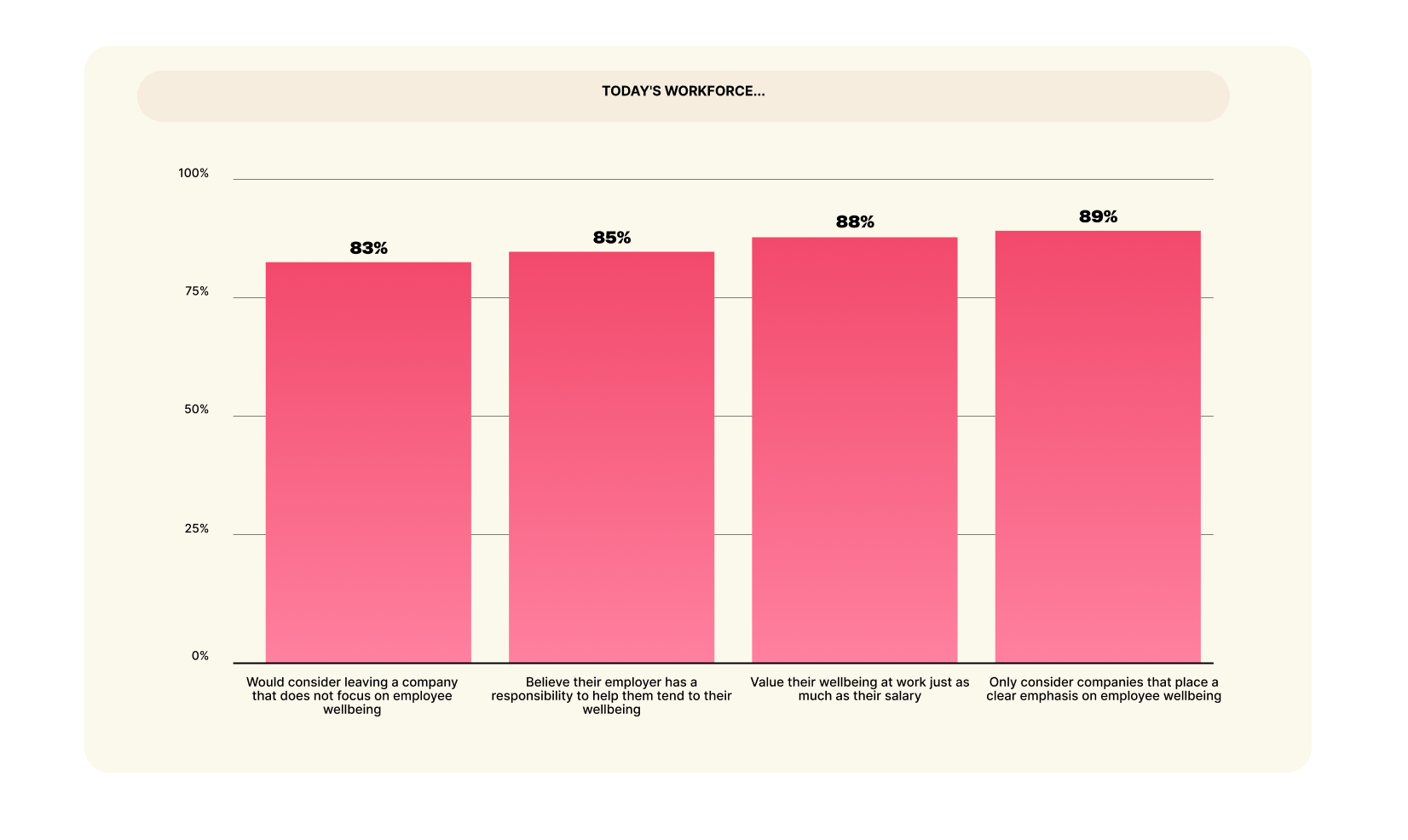
Boosted Productivity, Engagement, and Profitability
There’s a direct line from how employees feel to how they perform. Chronic stress and anxiety act like a handbrake on productivity – people have trouble concentrating, creativity plummets, and mistakes rise.
On the flip side, employees who feel emotionally supported are more engaged, focused, and productive. They take fewer sick days and bring more energy to their tasks. They are also less likely to engage in presenteeism, where they are physically at work but mentally checked out, which quietly drains far more productivity than obvious absenteeism.
By proactively addressing emotional wellness (through stress management resources, reasonable workloads, etc.), HR leaders can unlock higher performance. Companies with highly engaged employees see an 18% to 21% increase in productivity compared to those with lower engagement, according to recent Gallup and industry research. That adds up: Engaged employees also boost profitability by up to 23% for their organizations and are more likely to provide discretionary effort, leading on average to a 20% improvement in individual performance.
Enhanced Company Culture & Morale
Emotional wellness practices help build a culture of trust and safety. When employees see leaders openly discussing mental health, encouraging time off, or checking in on team members, it creates a ripple effect of empathy. Over time, this cultivates a workplace where people feel genuinely cared for.
The impact on morale is huge – teams become tighter and more supportive. Psychological safety (a key outcome of prioritizing wellbeing) means people aren’t afraid to speak up or make mistakes, which in turn fosters learning and collaboration. Also, when wellbeing is prioritized, 79% of employees with wellness programs say their HR department genuinely cares about them, compared to just 45% of employees without such programs. That gap highlights how much a well-implemented wellness strategy can boost overall morale and loyalty. A positive culture isn’t a fluffy nice thing; it’s the bedrock of sustained performance and employer reputation.
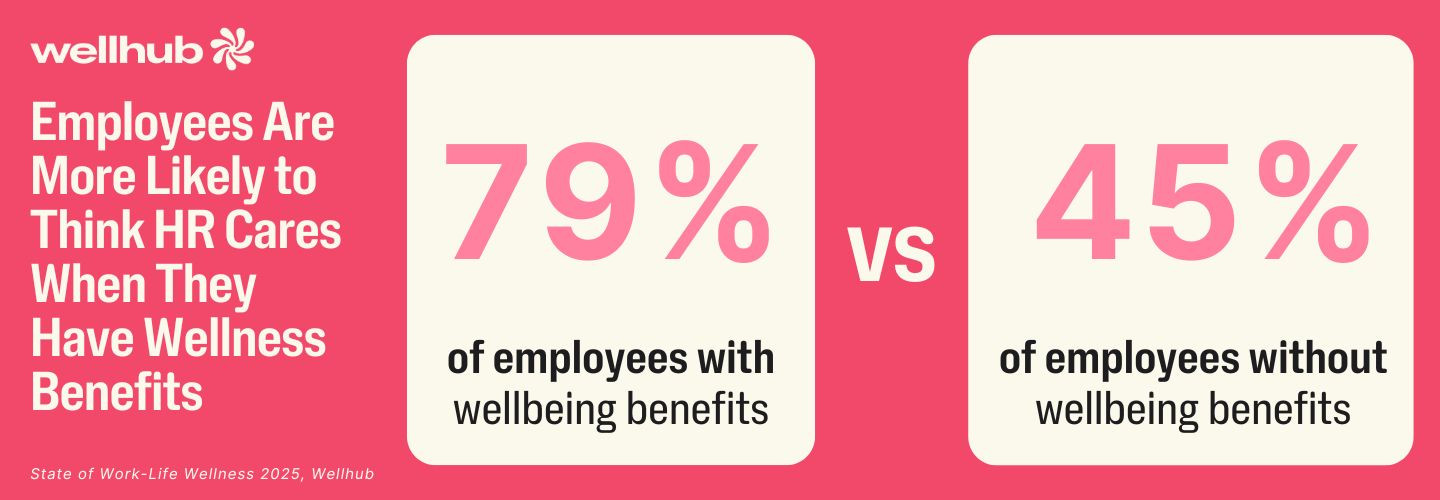
Attracting Top Talent
The next generation of talent is actively seeking employers who get it: 89% of employees will only consider job opportunities at companies that prioritize employee wellbeing.
That’s an astounding figure: Nearly nine in ten candidates are screening you for this. And this trend is only gaining steam, as young professionals, especially Gen Z, talk openly about mental health— expect their employers to do the same.
If your organization gains a reputation for supporting emotional wellness (through benefits, flexibility, etc.), you gain a competitive edge in recruitment. Top performers often have their pick of offers; a humane, wellbeing-centric culture can be the deciding factor that draws them to you over a competitor.
Mitigating Burnout & Lowering Costs
Finally, a comprehensive focus on emotional wellness is the antidote to burnout. Burnout doesn’t just sneak up; it accumulates from sustained stress and lack of recovery. By implementing preventive measures (like manageable workloads, mental health days, and manager training to spot burnout signs), companies can avoid costly burnout crises down the road. We’ve already seen how burnout drives turnover and lost productivity. It’s also linked to higher healthcare costs – stress contributes to everything from heart disease to insomnia, which can inflate your insurance premiums over time.

By proactively reducing stressors and encouraging healthy practices, organizations can trim those hidden costs. In one striking metric, the cost of voluntary turnover due to burnout alone accounts for roughly 15 to 20% of a company’s payroll each year. Preventing even a fraction of that through wellness initiatives can save millions. Plus, emotionally healthy employees are less likely to take unplanned absences – it all adds up to a more stable, cost-efficient operation.
To put the benefits in perspective, consider how employees with strong wellness support compare to those without:
Employee Outcomes With vs. Without Workplace Wellness Programs
| Employee Outcome | With a Wellness Program | Without a Wellness Program |
| Saw their mental wellness improve in the last year | 59% | 36% |
| Say they have time to take care of their wellbeing | 57% | 27% |
| Feel adequately compensated for their work | 84% | 61% |
| Believe HR genuinely cares about their wellbeing | 79% | 45% |
Source: 2025 Wellhub State of Work-Life Wellness Report
The business imperative is clear: Investing in emotional wellness is not just an altruistic move – it drives tangible improvements in retention, productivity, and overall performance. In an era where talent and innovation are key differentiators, no organization can afford to ignore this link.
Launch a wellness program that lifts engagement and lowers costs.
7 Ways to Build an Emotionally Healthy Workplace
Now let’s get practical. How can HR leaders actually create a work environment that supports emotional wellness every day?
Here are seven proven strategies – spanning leadership, management, programs, and culture – to help your employees thrive.
- Lead from the Top: Executive Buy-In & Modeling
Culture change starts at the top. When CEOs and executives prioritize their own wellbeing and speak openly about it, it gives everyone else permission to do the same. Secure leadership commitment by showing the ROI of wellness (for example, remind them that 78% of CEOs report over 50% returns on wellness investments – it truly pays off). Encourage leaders to model healthy behaviors: taking vacations, not emailing at midnight, talking about stress management in town halls. When the C-suite treats emotional wellness as a strategic priority, it filters down.
This also means budgeting for wellness – incorporating wellbeing goals into company strategy and dedicating resources. An executive champion who says “your mental health matters here” can spark a powerful shift in employee trust and participation.
- Manager Training & Development
Managers are the daily touchpoint for most employees, so they must be equipped to support emotional wellness. Offer training to help managers recognize signs of burnout or distress on their teams (e.g., sudden drops in performance, withdrawal, or increased absenteeism). Teach interpersonal skills like active listening and empathetic communication – often, an employee’s first line of relief is a one-on-one with a caring manager.
Also train managers in practical workload management: setting realistic goals, rotating high-pressure assignments, and encouraging their reports to take time off when needed. Empower managers to ask thoughtful questions in their check-ins, such as “How are you feeling about your workload lately?” or “What can I do to better support you this week?”. By normalizing these conversations, managers can catch issues early and connect employees with help (like adjusting deadlines or suggesting the EAP) before stress snowballs.
57 workplace wellness initiative ideas to transform employee wellbeing.
- Implement Robust Workplace Wellness Programs
A strong wellness program goes beyond a hotline or a single benefit — it’s about creating a holistic framework that supports employees’ physical, mental, and financial wellbeing. At a minimum, ensure your health insurance includes quality mental health coverage, and make sure employees know how to access it.
Modern wellness programs can include teletherapy options, on-site counseling, or virtual sessions for convenience. Workshops or app-based resources for mindfulness, meditation, or stress management give employees tools they can use anytime. Don’t overlook lifestyle factors like nutrition, sleep, and financial stability — wellness challenges, coaching, or financial planning resources can ease stress and boost resilience.
Personalization is key. One employee may value yoga classes, another might prefer career coaching or budgeting workshops. Conduct wellbeing surveys or assessments to understand your workforce’s needs, then build a diverse menu of resources. Finally, promote these offerings consistently and confidentially to reduce stigma. A well-rounded program shows employees that their whole wellbeing — mind and body — matters to the organization.
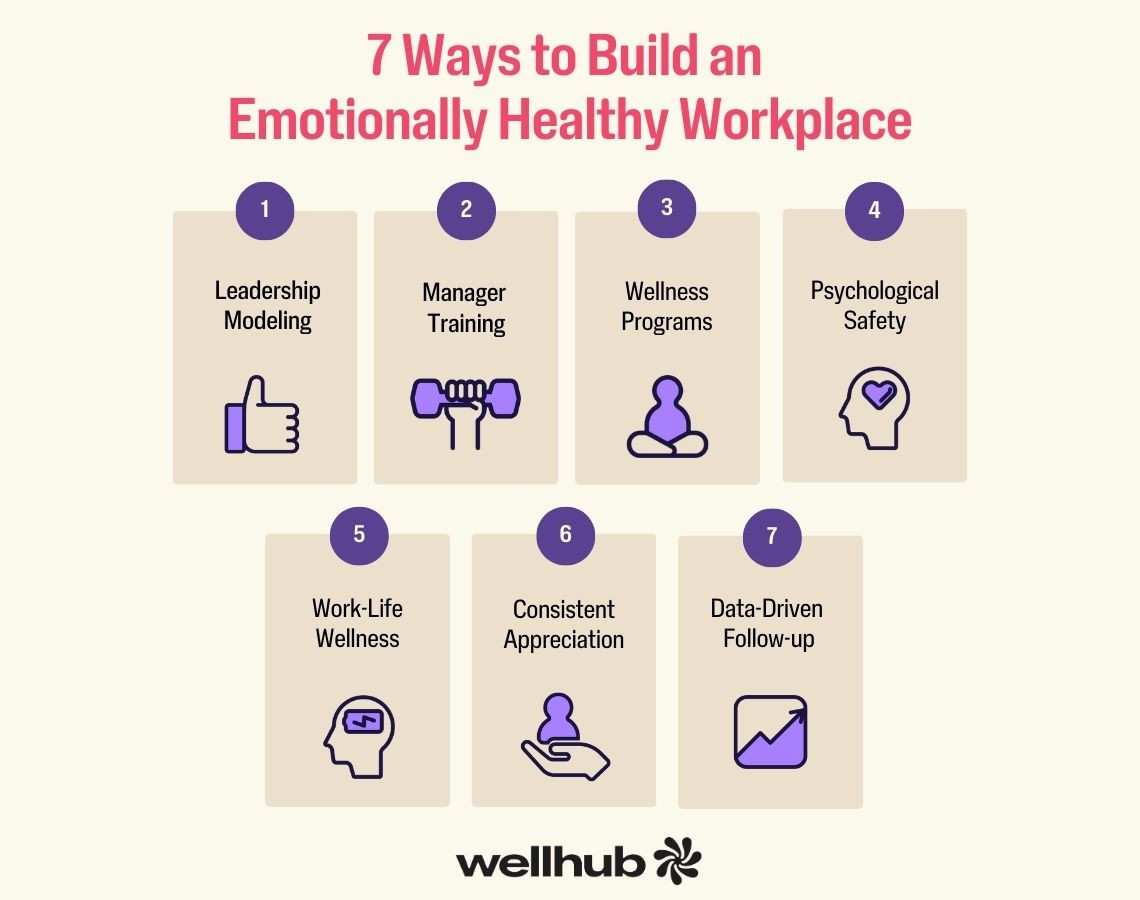
- Foster Psychological Safety & Open Communication
Make it standard practice to talk about mental health and stress at work, just like any other challenge. HR can lead initiatives to normalize these conversations – for example, host a Mental Health Awareness month event with speakers or personal stories from leaders.
Create safe spaces where employees can share concerns or feedback without fear of judgment or retaliation. This could be an anonymous feedback tool, regular listening sessions, or employee resource groups focused on wellbeing. Ensure your HR policies support this openness: review whether you have adequate flexible work options, mental health days, or clear protocols for employees to request accommodations or time off for mental health reasons.
When employees do speak up, respond with compassion and action. For instance, if someone says workload is overwhelming, managers and HR should collaborate on solutions (reprioritizing tasks, adjusting expectations, etc.). Over time, these practices build trust. Employees learn “It’s okay to say I’m struggling here” – a hallmark of an emotionally healthy workplace.
- Promote Work-Life Wellness & Boundaries
In our hyper-connected world, work can easily bleed into personal life. HR leaders should champion healthy boundaries. Set norms like no after-hours emails (or use delayed send).
Encourage leaders and managers to explicitly tell their teams it’s alright to disconnect in the evenings and on weekends. Flexible working arrangements can also greatly enhance work-life wellness – whether it’s remote work options, flexible hours to accommodate family needs, or compressed workweeks. By giving employees some control over when and where work happens, you reduce stress for those juggling life’s demands outside the office.
Additionally, educate employees on setting their own boundaries and managing time: maybe through a workshop on time management or simply sharing tips in the company newsletter. Remind everyone that taking breaks is not slacking – it’s refueling. Something as simple as encouraging a real lunch break or a short walk during the day can prevent burnout. When employees see their organization respecting their personal time, they return the favor with better focus and commitment during work time.
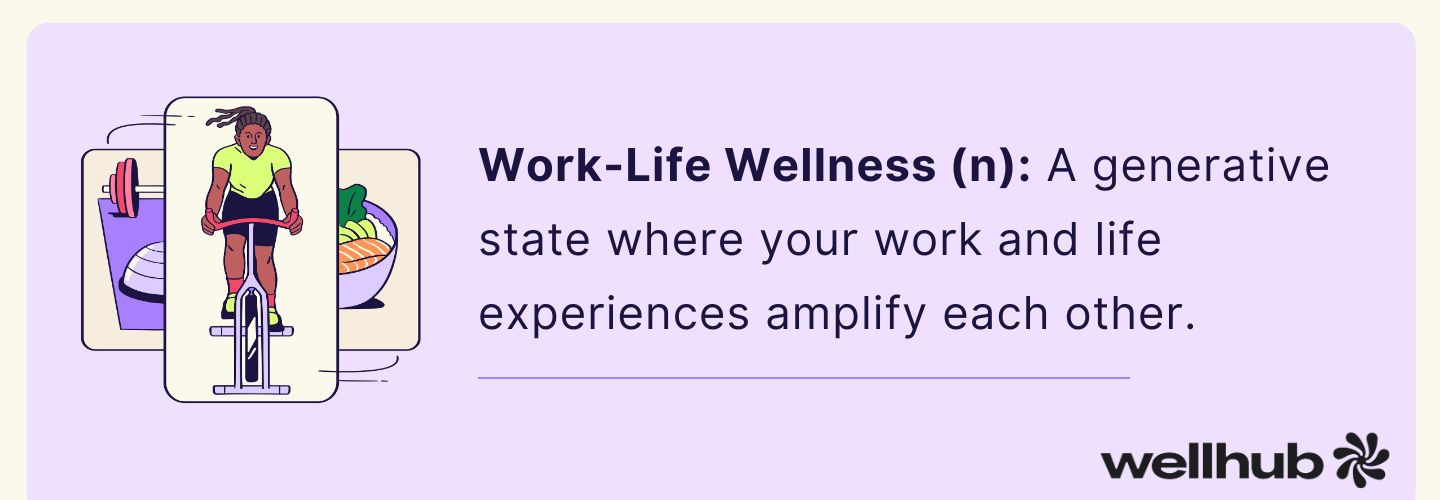
- Cultivate Recognition & Appreciation
Never underestimate the emotional boost that comes from feeling valued. Recognition programs are a powerful (and cost-effective) way to improve emotional wellness. Implement systems for employees to shout out each other’s good work – whether via a formal platform or a segment in team meetings. Train managers to give constructive, appreciative feedback regularly, not just during annual reviews. Little gestures, like a thank-you email or a mention in the company newsletter for someone who went above and beyond, go a long way.
Some companies hold “gratitude sessions” or dedicate a few minutes in meetings for team members to recognize peers. This not only makes individuals feel good, but also builds a sense of community and support. When people know their efforts are seen and appreciated, it combats feelings of cynicism and “why am I doing this?” that feed burnout. Over time, a culture of recognition leads to employees who are more engaged, collaborative, and emotionally positive at work.
- Take a Data-Driven Approach: Measure & Evaluate
You can’t improve what you don’t measure. Treat your emotional wellness initiatives like any other key program: track their impact.
Use surveys to gather employee feedback on stress levels, work-life balance, and use of wellness resources. Look at metrics like absenteeism, turnover rates, and healthcare claims for stress-related issues to see if they improve after interventions. Many companies now include wellbeing questions in their regular employee engagement surveys (e.g., “I feel my company cares about my wellbeing” – track that score over time).
Also consider usage stats: what percentage of the team is using your EAP or joining wellness webinars? If engagement is low, that’s a sign you might need to communicate more or tweak offerings. By analyzing this data, HR can pinpoint what’s working and what isn’t. For example, if you notice a department with higher burnout scores, you can target manager training there. Or if flexible hours led to decreased absenteeism in one pilot group, you can make the case to expand it company-wide. Continuous improvement is the name of the game – use data to refine your wellbeing programs and demonstrate their ROI. This not only makes your initiatives more effective, but also helps convince executives to continue investing in them (after all, you’ll have the numbers to prove it’s making a difference!).
Start small if you need to – even one or two changes can begin to shift the atmosphere. The key is to be consistent and genuine. Employees will notice the effort and, over time, you’ll see the results: a happier team, a more resilient organization, and an HR leader (that’s you!) who has truly made a positive impact.
Physical activity bolsters emotional health. Here's how to get employees up and moving:
- 30 workplace wellness activities
- 17 plug-and-play physical wellness ideas
- 5 actionable employee fitness challenge ideas
- The Ultimate Guide to Workplace Wellness Challenges for HR Leaders
Empowering Employees: Resources HR Can Provide
Even with a great culture and proactive managers, employees will face personal challenges. A crucial role for HR is to empower individuals with tools and resources to take charge of their own emotional wellness. By offering a variety of supports, you acknowledge that everyone copes differently – and you give your people avenues to build resilience.
Here are some valuable resources and practices you can provide to your workforce:
- Stress Management Techniques: Introduce employees to stress reduction practices they can use on the job or at home. This might include guided mindfulness meditation sessions (there are plenty of apps and programs that offer short daily meditations), breathing exercises, or on-site yoga classes. Some companies create quiet wellness rooms where people can take a ten-minute meditation or stretch break during hectic days. Also, consider organizing short workshops on topics like time management, avoiding multitasking, or even desk stretches – anything that helps manage the physical and mental effects of stress. Giving people permission and tools to decompress during work can prevent small stressors from escalating.
- Resilience Building Programs: Resilience isn’t just an inborn trait; it’s a skill that can be nurtured. HR can offer training on techniques like cognitive reframing (learning to challenge and change negative thought patterns), goal-setting and prioritization, or identifying personal strengths. Providing seminars or resources on developing a growth mindset can help employees handle setbacks more constructively. Encourage employees to identify their core values and what gives them purpose, because aligning work with personal values can buffer against stress. Simple initiatives, like a book club on resilience or distributing tip-sheets on coping strategies, show that you’re invested in helping employees build inner strength.
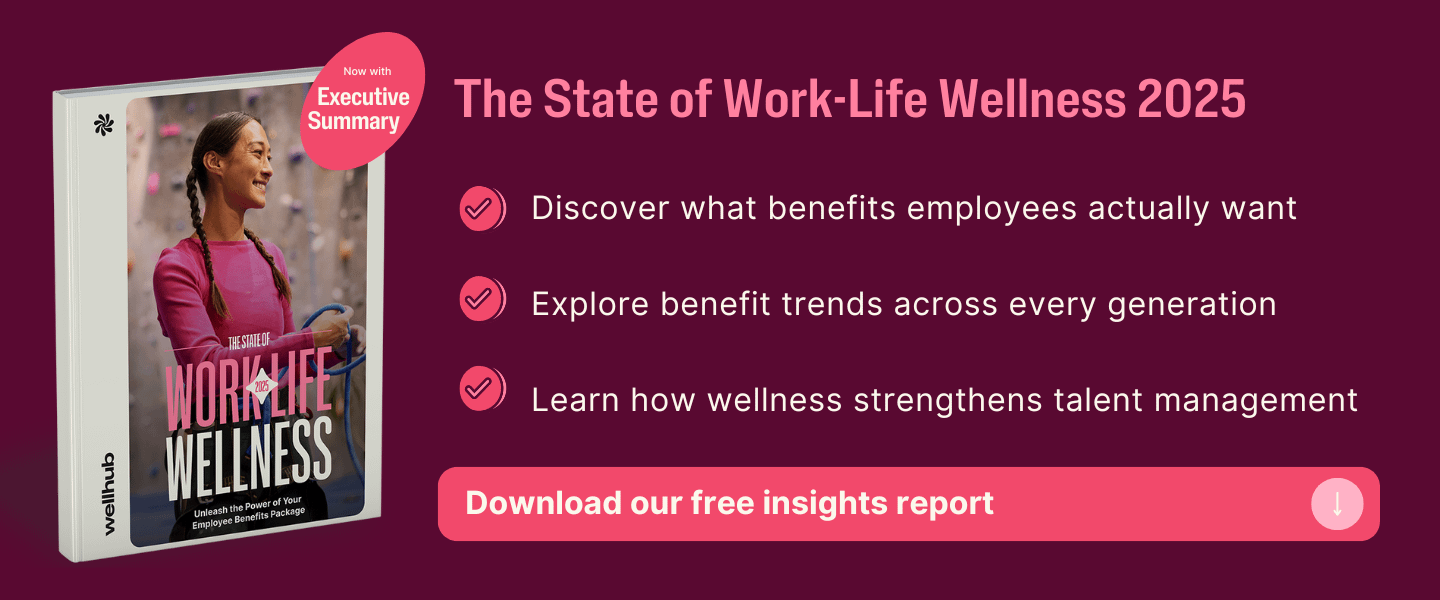
- Conflict Resolution & Communication Skills: Interpersonal conflicts or communication breakdowns are a huge source of workplace stress. Offering communication skills training can empower employees to express their needs and resolve issues before they become emotional drains. Consider workshops on topics like active listening, giving and receiving feedback, or managing difficult conversations. You might also train peer mediators or designate ombudspersons who can confidentially help employees navigate conflicts. When people have the skills to address friction in healthy ways, it prevents stress from unresolved tensions and contributes to a more emotionally harmonious workplace.
- Access to External Resources: Sometimes the best help comes from outside the organization. Make sure employees know about and can access external support when needed. This includes robust health insurance coverage for therapy or counseling, as mentioned earlier, and clear information on how to use it. Develop a list of community resources: for example, local support groups (for grief, addiction, etc.), free or sliding-scale counseling clinics, or mental health nonprofits. Share national hotlines for crises (like the 988 Suicide & Crisis Lifeline in the U.S.) in your internal communications or posters – normalize using them. Partner with your EAP provider to deliver lunch-and-learn sessions on emotional health topics or to send monthly wellbeing newsletters. If you have the budget, you could even offer stipends that employees can use on wellness-related expenses (gym memberships, meditation apps, etc.). The goal is to make it easy for employees to seek help and improve their wellbeing beyond what the company directly provides.
By equipping employees with these resources, HR empowers everyone to be an active participant in their own emotional wellness journey.
Keep top talent inspired with this professional growth blueprint. [20 ideas]
Common Challenges & Solutions for HR Leaders
Even when you’re on board with prioritizing emotional wellness, real-world obstacles can emerge. Budget constraints, stigma, low engagement – these are challenges many HR leaders face when implementing wellness initiatives. The key is to anticipate them and have strategies ready to address them.
Let’s explore some common challenges and how to solve them:
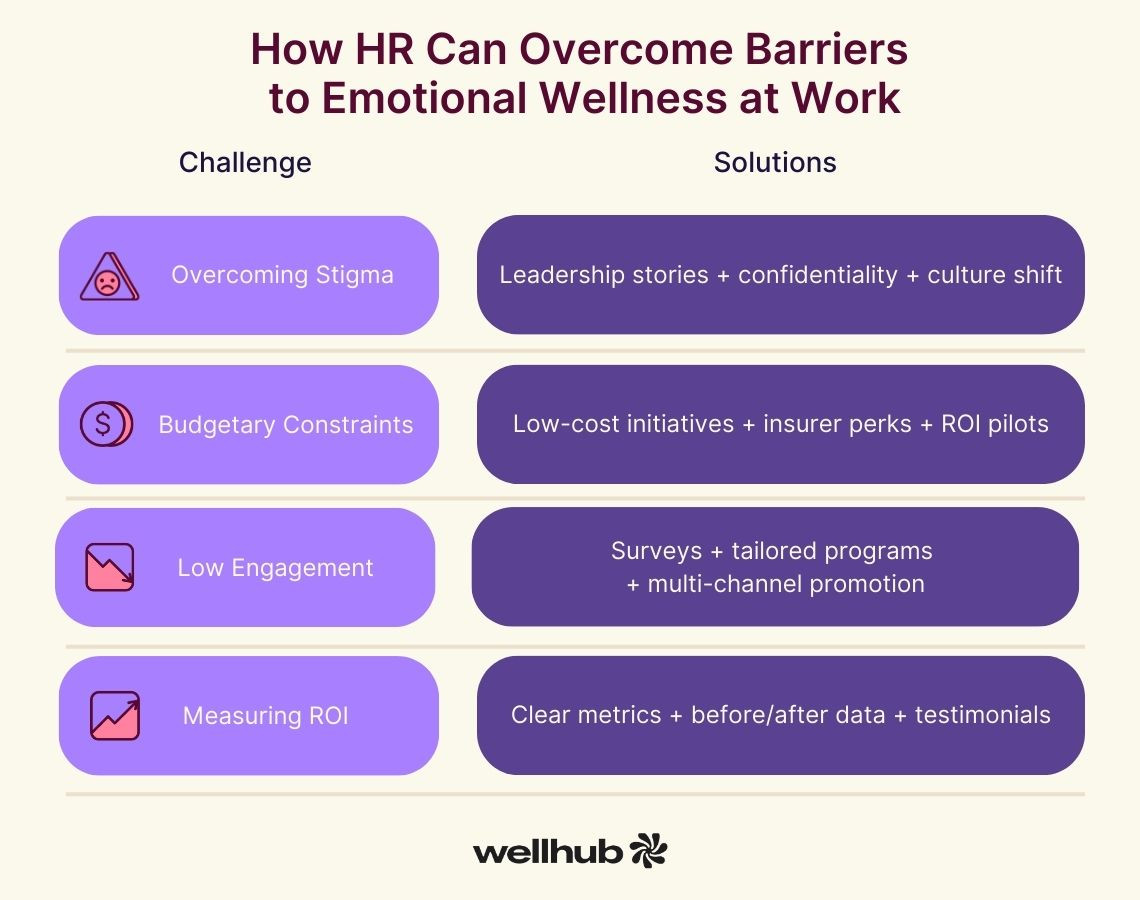
Overcoming Stigma
Challenge: Despite progress, some employees may still feel that seeking help for stress or mental health will label them as “weak” or harm their career. This stigma can lead to low utilization of programs – an EAP is useless if nobody calls it.
Solution: Culture and leadership have to actively combat stigma. Encourage leaders and managers to share their own experiences with stress or burnout (to the extent they’re comfortable). When a respected executive says, “I’ve spoken to a therapist and it helped me,” it powerfully normalizes help-seeking. Train managers to routinely remind their teams that using mental health days or counseling resources will not jeopardize their job – in fact, it’s encouraged. Also emphasize confidentiality of any services (many employees fear their personal struggles will be known – assure them that EAP or therapy use is private). Celebrate those who take steps for self-care, perhaps in anonymous ways (like, “X number of employees utilized our counseling sessions this quarter – great to see people prioritizing wellbeing!”). Over time, consistent messaging will chip away at stigma and replace it with a culture of support.
Budgetary Constraints
Challenge: Not every organization has a Fortune 500 budget for elaborate wellness programs. HR might struggle to get funding for new initiatives if leadership is focused elsewhere.
Solution: Remember that not all impactful wellness strategies cost a lot. Start with low-cost, high-impact initiatives: for example, manager training sessions can be done in-house or with affordable online courses. Flexible work arrangements cost little or nothing to implement, yet yield significant wellbeing benefits. Peer support programs or forming a wellness committee of employees are inexpensive ways to generate ideas and momentum. Leverage free community resources as well – invite a local nonprofit speaker for a lunch talk on mental health, or use free meditation apps. To unlock more budget, focus on demonstrating ROI: gather data (even small-scale) from pilot programs to show improvements in retention or reduced sick days, then present that to executives. Often, showing that, say, a modest $5,000 investment in wellness saved $20,000 in turnover costs can open purse strings. You can also explore partnering with health insurers, many of whom offer free wellness programs or discounts as part of their service, or using wellness dollars, which can help pay for programs. In short, be creative and strategic – great wellness support is possible at any budget level.
Here’s how to find a whole-person wellness program that boosts performance.
Low Employee Engagement
Challenge: You rolled out a new wellness program… and then only a handful of employees participated. Low engagement can happen if programs aren’t appealing, people are too busy, or they’re skeptical.
Solution: Customization and communication are your best friends here. First, find out what employees actually want – run a quick survey or hold focus groups to ask which wellness activities or benefits would interest them. You might discover that your largely remote workforce prefers virtual options like meditation apps over on-site yoga, for instance. Tailor programs to diverse needs: offer a variety (physical fitness, relaxation, creative outlets, family-friendly activities) so there’s something for everyone. Next, rev up your communication: don’t just send one email and call it a day. Promote wellness offerings through multiple channels – team meetings, company chat platforms, posters in the break room, even manager one-on-ones. Highlight personal stories: e.g., an employee who shares “that stress workshop really helped me sleep better.” Sometimes incentives help to kick-start engagement (small rewards for participation or fun team challenges). And importantly, if uptake is low, don’t view it as failure – view it as feedback. Keep experimenting with formats and timing (maybe lunchtime sessions were tough; try a morning or recorded option). By involving employees in the design and promotion of wellness initiatives, they’ll have more ownership and interest.
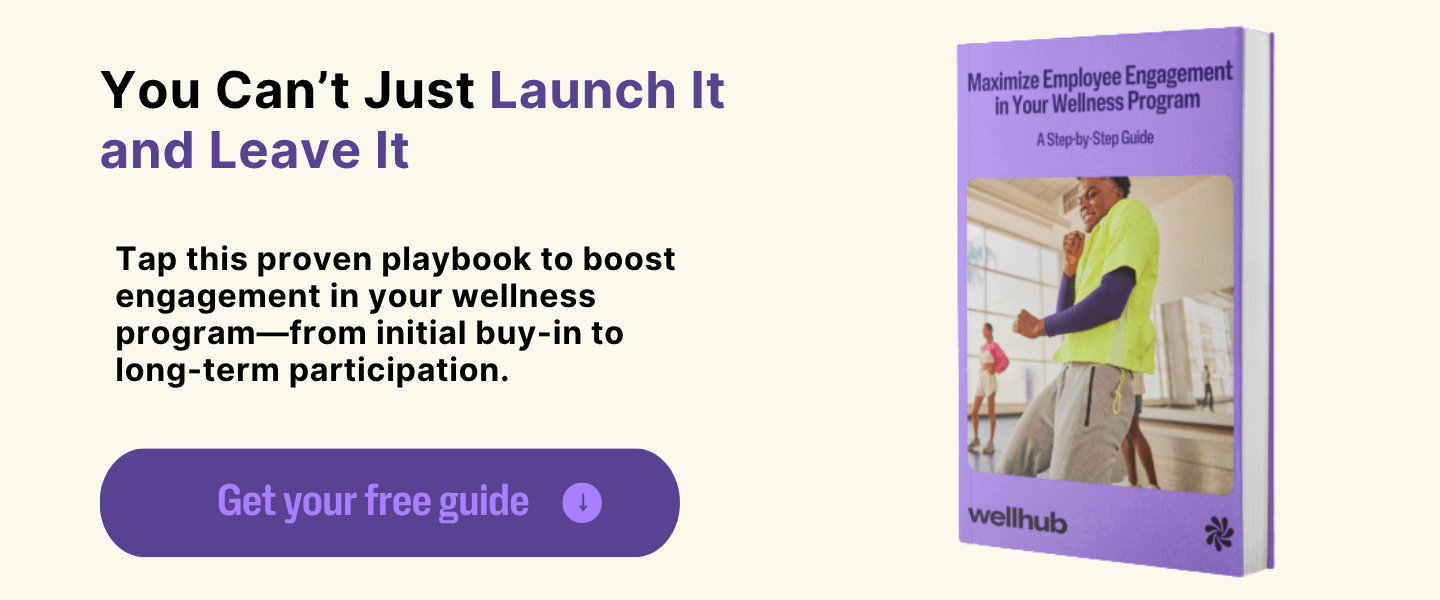
Measuring ROI
Challenge: Leadership asks, “How do we know all these wellness efforts are actually working?” It can be tricky to draw straight lines between a mindfulness program and quarterly profits.
Solution: Establish clear metrics from the start and track them consistently. Define what success looks like: Is it reduced turnover? Fewer sick days? Higher self-reported wellbeing scores? Use a mix of data: hard metrics (absenteeism rates, retention rates, healthcare claim costs if available) and soft metrics (employee survey results on stress or engagement). Many companies compare “before and after” for departments or pilot groups to gauge impact. If you introduced flexible Fridays, did those teams see improved morale scores or productivity metrics over 6 months? Correlate wellness initiatives with business outcomes whenever possible: for example, if turnover dropped 5% after introducing a new program, that’s significant (even if not purely causal, it’s a strong association to highlight). Also, gather testimonials – a manager saying “my team is performing better since we started weekly check-ins about workload” is qualitative ROI. Present findings in executive-friendly terms: e.g., “Wellness initiative X likely saved us $Y in recruiting costs by retaining Z employees,” or “Our engagement score rose 10%, which research links to higher customer satisfaction.” Even if some of it is estimation, tying wellbeing to tangible business KPIs will build credibility. Over time, as your data series grows, the ROI picture will get clearer. Remember, many forward-thinking CEOs already believe in this – 58% of CEOs strongly agree wellbeing is critical to financial success – so lean on that mindset and keep delivering both the numbers and the narrative.
Every small victory – an employee who says “thank you, I felt supported,” or a quarterly report showing improved retention – is a step toward a healthier, more resilient workplace.
Emotional Wellness in the Workplace FAQs
Finally, let’s address some of the frequently asked questions HR leaders have about emotional wellness at work. These quick Q&As will help clarify common concerns:
Q: What is the difference between mental health and emotional wellness?
A: Mental health is a broad term referring to an individual’s overall psychological state – it includes conditions like depression or anxiety, as well as general emotional and cognitive well-being. Emotional wellness, in a workplace context, specifically focuses on how well a person can manage and respond to the emotional demands of their job and work environment.
Think of emotional wellness as the day-to-day practice of maintaining a healthy emotional balance (managing stress, staying positive, feeling fulfilled), whereas mental health can encompass long-term mental disorders and overall mental state. They overlap a lot – good emotional wellness supports mental health – but someone could have no diagnosed mental illness and still feel emotionally unwell due to work stress, for example.
Q: Why should my company invest in emotional wellness programs?
A: Because the payoff is significant – both for your people and your business. Emotionally well employees are more engaged, productive, and loyal. They collaborate better and provide better service to customers.
Conversely, when employees are struggling emotionally, it leads to burnout, errors, conflicts, and higher turnover, all of which are very costly. Investing in wellness programs (like counseling, stress management, and work-life balance initiatives) can reduce absenteeism and turnover costs and improve performance.
Beyond the numbers, it also builds a positive employer brand – companies known for caring about their employees attract top talent. In essence, emotional wellness programs help create a workforce that’s not just present, but fully present and motivated. Many executives see it now as a strategic investment, not just an HR expense, because it drives innovation and competitive advantage through a healthier, more resilient team.
We made it easy: Launch your wellness program with this step-by-step guide.
Q: How can HR leaders gain executive buy-in for emotional wellness initiatives?
A: Start by speaking the language of the C-suite: data and ROI. Present compelling statistics (for example, stress-related turnover can cost millions, and companies are seeing up to a 200% return on wellness investments). Use any internal data you have – perhaps your employee survey shows low wellbeing scores correlating with higher quit rates. Build a business case that connects wellness to outcomes the execs care about, like productivity, retention, and employer reputation.
share success stories from other organizations or competitors that have thriving wellness programs. Appeal to the fact that 23% of CHROs have wellbeing as a top priority in 2024, indicating a clear market trend. Finally, identify an executive champion if possible – maybe a senior leader who personally values mental health – and have them co-sponsor the initiative. When executives see that emotional wellness is a lever for achieving strategic goals (and that employees increasingly expect it), they’re far more likely to support funding and participation.
Q: What are some low-cost ways to promote emotional wellness?
A: Not every effective wellness strategy requires a big budget. Here are a few low or no-cost ideas:
- Flexible Scheduling: Allow some remote work days or flexible hours. Autonomy over schedules greatly reduces stress and costs nothing.
- Peer Support Groups: Facilitate the creation of interest groups or support circles (e.g., new parents group, meditation club, running group). These can be run voluntarily by employees.
- Lunch & Learn Sessions: Invite guest speakers (perhaps a local psychologist or a yoga instructor who might volunteer a session) or use free webinars to educate employees on stress management and self-care.
- Gratitude and Recognition: Implement shout-out rituals where employees recognize each other’s good work in meetings or internal forums. Feeling appreciated improves emotional wellbeing and it’s free.
- Encourage Breaks: Lead a campaign for micro-breaks – maybe set a policy that everyone steps away from their desk for 10 minutes in the afternoon. Sometimes, just giving permission for self-care is all that’s needed.
- Manager One-on-Ones: Train managers to include a “how are you doing?” check-in about workload or stress in their regular one-on-ones. It doesn’t cost anything to show empathy, and it can surface issues early.
In summary, focus on cultural practices and leveraging internal resources. Often, genuine concern and consistency go farther than flashy programs. Start small, build trust, and you can add more as you grow.
Q: How can we measure the effectiveness of our emotional wellness programs?
A: Measurement is key to knowing if you’re moving the needle. Use a combination of:
- Employee Surveys: Specifically track metrics like self-reported stress levels, job satisfaction, work-life balance, and feeling of support. Comparing survey results from before and after program implementation is insightful.
- Utilization Rates: Monitor how many employees are using various resources (EAP usage, counseling sessions, attendance in workshops, etc.). Low use might mean you need to adjust the program or communication.
- HR Metrics: Look at hard data such as turnover rates, absenteeism, and productivity indicators (like output or error rates) over time. If these improve after wellness initiatives, that’s a strong sign of impact. For example, if voluntary turnover drops from 15% to 10% after a year of wellness programs, you can estimate cost savings.
- Healthcare Claims (if available): Some companies analyze health insurance data for claims related to stress (e.g., antidepressants, stress-related conditions). A reduction or slower increase in these costs can be attributed to better employee wellbeing.
- Feedback and Testimonials: Qualitative data is useful too. Gather stories or quotes from employees about how the programs helped them (e.g., “That mindfulness course helped me manage my anxiety and I’m so grateful”). These narratives can be shared with leadership to give color to the numbers.
By regularly reviewing these measures, you can see what’s working and what isn’t. Importantly, share these results with stakeholders. Demonstrating, say, a 5:1 return in reduced turnover cost or a rise in engagement scores will help keep support for the programs strong.
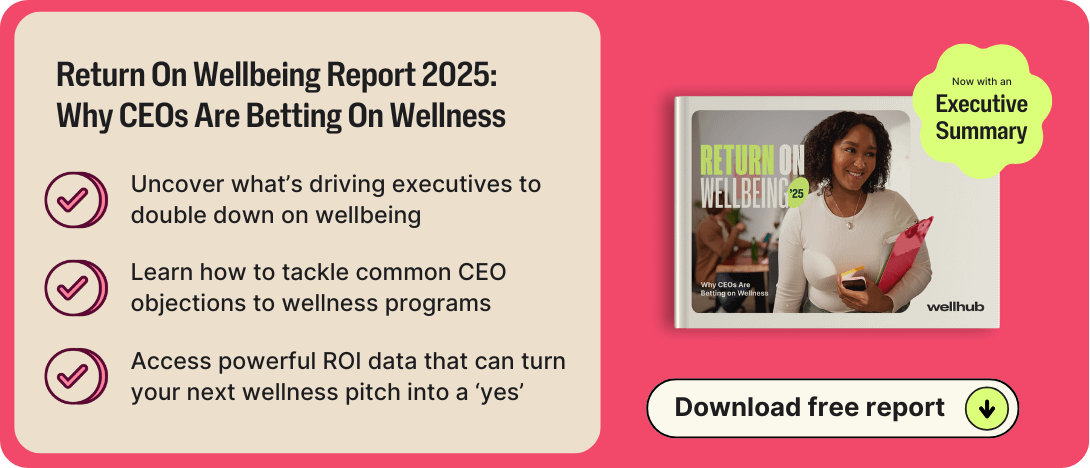
Q: How do we address stigma around emotional wellness in the workplace?
A: Combating stigma requires a cultural shift, and HR can lead the charge. Start by educating the workforce: provide information that mental health struggles are common and treatable, just like physical illnesses. Encourage leaders at all levels to speak up – for example, an executive might share how therapy or meditation has helped them manage work stress. When employees see role models being open, it normalizes the conversation. Incorporate mental health into your diversity and inclusion efforts, recognizing it as part of creating a truly inclusive workplace.
Also, make sure policies back up the talk: if people take mental health days, ensure they are treated the same as physical sick days. Celebrate the use of wellbeing benefits rather than treating it as something to hide. You could also host workshops or panels with mental health professionals or people who share recovery stories. The more visible and talked-about emotional wellness becomes, the less it lives in the shadows. Over time, these efforts build an environment where seeking help is seen as a strength, not a weakness. Patience is key – stigma doesn’t evaporate overnight, but consistent, genuine messaging will erode it.
Emotional Wellness Can’t Wait — And Neither Can Your Benefits Strategy
The emotional health of today’s workforce is under pressure. Burnout, stress, and emotional fatigue are driving turnover, draining productivity, and threatening company culture. Employees feel overwhelmed, undervalued, and unsure where to turn for support.
An effective employee wellbeing program can reverse that trend. By giving your people access to tools like stress management, resilience training, and mental health resources, you create a workplace where employees feel safe, supported, and energized. That kind of culture pays off — 75% of employees with Wellhub say their mental wellbeing improved over the last year, compared to 43% of employees without Wellhub.
Speak with a Wellhub Wellbeing Specialist to build a culture that supports emotional wellness across your organization.

Company healthcare costs drop by up to 35% with Wellhub*
See how we can help you reduce your healthcare spending.
[*] Based on proprietary research comparing healthcare costs of active Wellhub users to non-users.
Category
Share

The Wellhub Editorial Team empowers HR leaders to support worker wellbeing. Our original research, trend analyses, and helpful how-tos provide the tools they need to improve workforce wellness in today's fast-shifting professional landscape.
Subscribe
Our weekly newsletter is your source of education and inspiration to help you create a corporate wellness program that actually matters.
Subscribe
Our weekly newsletter is your source of education and inspiration to help you create a corporate wellness program that actually matters.
You May Also Like

FSA vs. HSA Strategy for HR Leaders | Wellhub
Compare FSA vs HSA rules, tax advantages, eligibility, and rollover differences to help employees choose the right account and avoid costly compliance issues.

Employee Wellness Programs: Key Components for Success | Wellhub
Transform your workplace wellness strategy by integrating physical, mental, financial, and social wellbeing into a comprehensive wellness program that works

Benefits Strategy Roadmap: Pull and Retain Top Talent | Wellhub
Support wellbeing, reduce turnover, and maximize ROI with a benefits strategy built for today’s workforce—not yesterday’s spreadsheet.